Accounting for Fair Valuation, Intangibles and Employee Benefits
VerifiedAdded on 2020/04/07
|9
|2159
|41
Homework Assignment
AI Summary
This assignment solution addresses key aspects of accounting, including the fair valuation of assets according to AASB 116, covering both cost and revaluation models. It provides journal entries for asset valuation, depreciation, and revaluation surplus or loss. The solution further delves into intangible assets as per AASB 138, differentiating between acquired and internally generated assets and discussing accounting treatments. The assignment also examines employee benefits, specifically defined benefit obligations, calculating present values, net liabilities, and related journal entries for superannuation expenses, contributions, and actuarial gains/losses. It provides detailed workings and calculations, including the impact of past service costs, interest, and plan asset returns, offering a comprehensive understanding of these financial accounting topics.
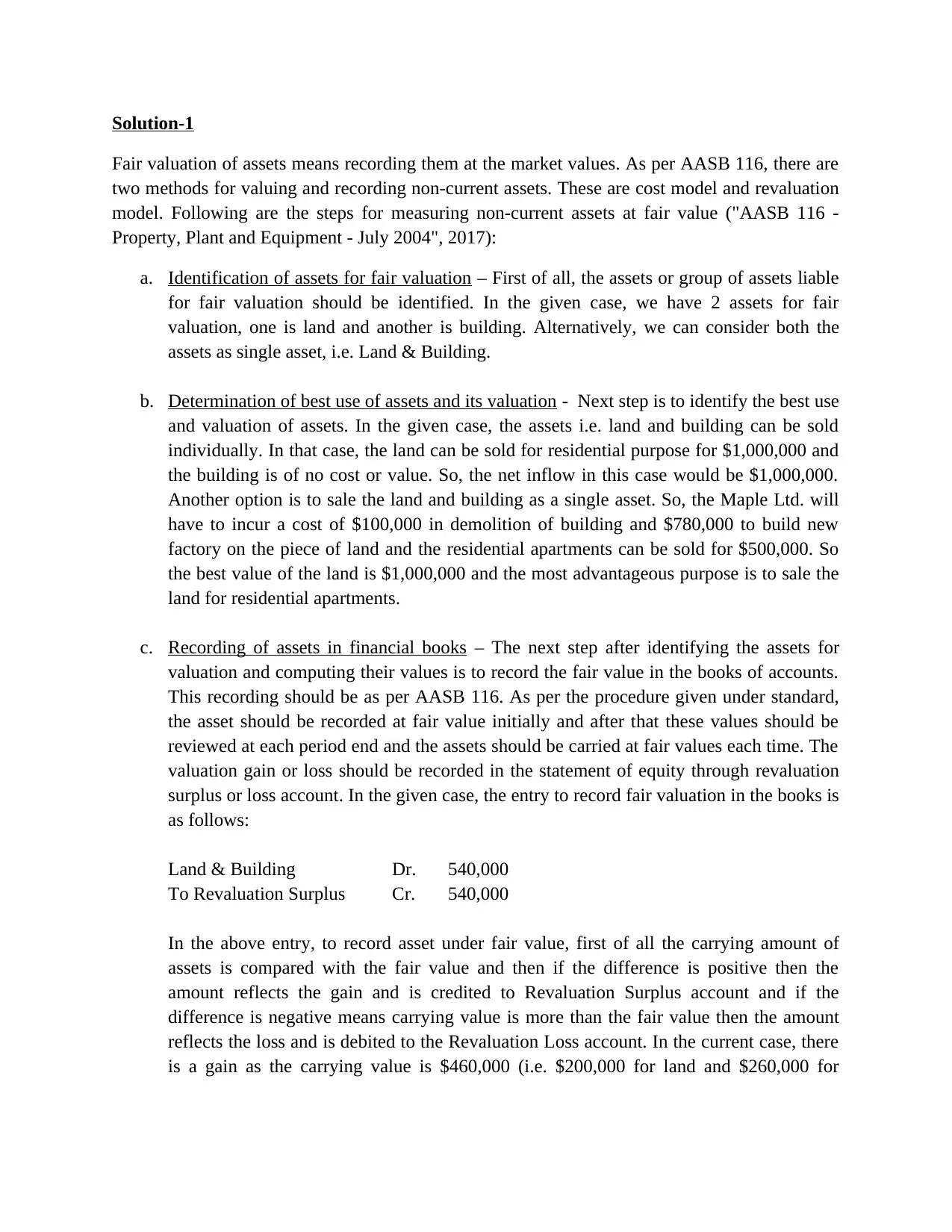
Solution-1
Fair valuation of assets means recording them at the market values. As per AASB 116, there are
two methods for valuing and recording non-current assets. These are cost model and revaluation
model. Following are the steps for measuring non-current assets at fair value ("AASB 116 -
Property, Plant and Equipment - July 2004", 2017):
a. Identification of assets for fair valuation – First of all, the assets or group of assets liable
for fair valuation should be identified. In the given case, we have 2 assets for fair
valuation, one is land and another is building. Alternatively, we can consider both the
assets as single asset, i.e. Land & Building.
b. Determination of best use of assets and its valuation - Next step is to identify the best use
and valuation of assets. In the given case, the assets i.e. land and building can be sold
individually. In that case, the land can be sold for residential purpose for $1,000,000 and
the building is of no cost or value. So, the net inflow in this case would be $1,000,000.
Another option is to sale the land and building as a single asset. So, the Maple Ltd. will
have to incur a cost of $100,000 in demolition of building and $780,000 to build new
factory on the piece of land and the residential apartments can be sold for $500,000. So
the best value of the land is $1,000,000 and the most advantageous purpose is to sale the
land for residential apartments.
c. Recording of assets in financial books – The next step after identifying the assets for
valuation and computing their values is to record the fair value in the books of accounts.
This recording should be as per AASB 116. As per the procedure given under standard,
the asset should be recorded at fair value initially and after that these values should be
reviewed at each period end and the assets should be carried at fair values each time. The
valuation gain or loss should be recorded in the statement of equity through revaluation
surplus or loss account. In the given case, the entry to record fair valuation in the books is
as follows:
Land & Building Dr. 540,000
To Revaluation Surplus Cr. 540,000
In the above entry, to record asset under fair value, first of all the carrying amount of
assets is compared with the fair value and then if the difference is positive then the
amount reflects the gain and is credited to Revaluation Surplus account and if the
difference is negative means carrying value is more than the fair value then the amount
reflects the loss and is debited to the Revaluation Loss account. In the current case, there
is a gain as the carrying value is $460,000 (i.e. $200,000 for land and $260,000 for
Fair valuation of assets means recording them at the market values. As per AASB 116, there are
two methods for valuing and recording non-current assets. These are cost model and revaluation
model. Following are the steps for measuring non-current assets at fair value ("AASB 116 -
Property, Plant and Equipment - July 2004", 2017):
a. Identification of assets for fair valuation – First of all, the assets or group of assets liable
for fair valuation should be identified. In the given case, we have 2 assets for fair
valuation, one is land and another is building. Alternatively, we can consider both the
assets as single asset, i.e. Land & Building.
b. Determination of best use of assets and its valuation - Next step is to identify the best use
and valuation of assets. In the given case, the assets i.e. land and building can be sold
individually. In that case, the land can be sold for residential purpose for $1,000,000 and
the building is of no cost or value. So, the net inflow in this case would be $1,000,000.
Another option is to sale the land and building as a single asset. So, the Maple Ltd. will
have to incur a cost of $100,000 in demolition of building and $780,000 to build new
factory on the piece of land and the residential apartments can be sold for $500,000. So
the best value of the land is $1,000,000 and the most advantageous purpose is to sale the
land for residential apartments.
c. Recording of assets in financial books – The next step after identifying the assets for
valuation and computing their values is to record the fair value in the books of accounts.
This recording should be as per AASB 116. As per the procedure given under standard,
the asset should be recorded at fair value initially and after that these values should be
reviewed at each period end and the assets should be carried at fair values each time. The
valuation gain or loss should be recorded in the statement of equity through revaluation
surplus or loss account. In the given case, the entry to record fair valuation in the books is
as follows:
Land & Building Dr. 540,000
To Revaluation Surplus Cr. 540,000
In the above entry, to record asset under fair value, first of all the carrying amount of
assets is compared with the fair value and then if the difference is positive then the
amount reflects the gain and is credited to Revaluation Surplus account and if the
difference is negative means carrying value is more than the fair value then the amount
reflects the loss and is debited to the Revaluation Loss account. In the current case, there
is a gain as the carrying value is $460,000 (i.e. $200,000 for land and $260,000 for
Paraphrase This Document
Need a fresh take? Get an instant paraphrase of this document with our AI Paraphraser
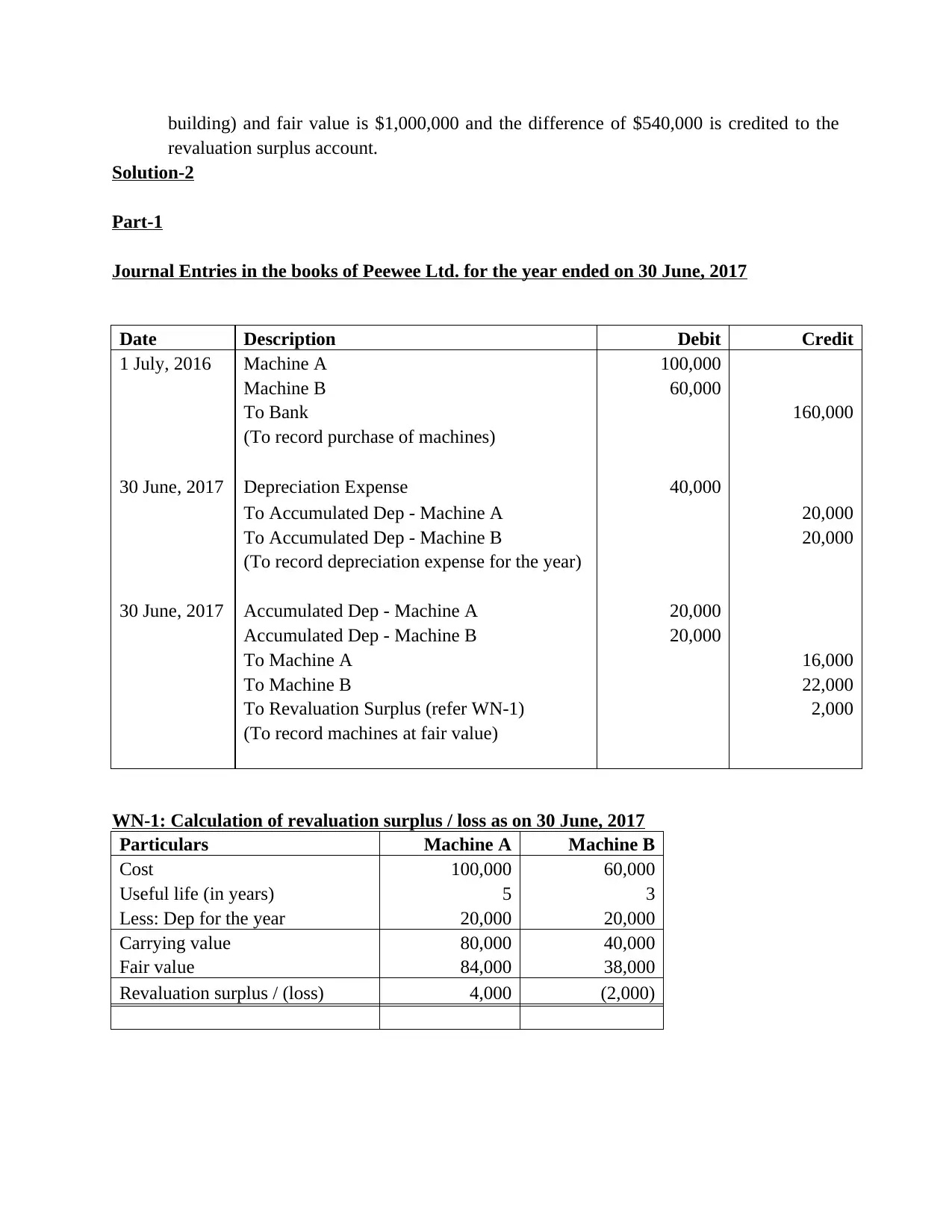
building) and fair value is $1,000,000 and the difference of $540,000 is credited to the
revaluation surplus account.
Solution-2
Part-1
Journal Entries in the books of Peewee Ltd. for the year ended on 30 June, 2017
Date Description Debit Credit
1 July, 2016 Machine A 100,000
Machine B 60,000
To Bank 160,000
(To record purchase of machines)
30 June, 2017 Depreciation Expense 40,000
To Accumulated Dep - Machine A 20,000
To Accumulated Dep - Machine B 20,000
(To record depreciation expense for the year)
30 June, 2017 Accumulated Dep - Machine A 20,000
Accumulated Dep - Machine B 20,000
To Machine A 16,000
To Machine B 22,000
To Revaluation Surplus (refer WN-1) 2,000
(To record machines at fair value)
WN-1: Calculation of revaluation surplus / loss as on 30 June, 2017
Particulars Machine A Machine B
Cost 100,000 60,000
Useful life (in years) 5 3
Less: Dep for the year 20,000 20,000
Carrying value 80,000 40,000
Fair value 84,000 38,000
Revaluation surplus / (loss) 4,000 (2,000)
revaluation surplus account.
Solution-2
Part-1
Journal Entries in the books of Peewee Ltd. for the year ended on 30 June, 2017
Date Description Debit Credit
1 July, 2016 Machine A 100,000
Machine B 60,000
To Bank 160,000
(To record purchase of machines)
30 June, 2017 Depreciation Expense 40,000
To Accumulated Dep - Machine A 20,000
To Accumulated Dep - Machine B 20,000
(To record depreciation expense for the year)
30 June, 2017 Accumulated Dep - Machine A 20,000
Accumulated Dep - Machine B 20,000
To Machine A 16,000
To Machine B 22,000
To Revaluation Surplus (refer WN-1) 2,000
(To record machines at fair value)
WN-1: Calculation of revaluation surplus / loss as on 30 June, 2017
Particulars Machine A Machine B
Cost 100,000 60,000
Useful life (in years) 5 3
Less: Dep for the year 20,000 20,000
Carrying value 80,000 40,000
Fair value 84,000 38,000
Revaluation surplus / (loss) 4,000 (2,000)
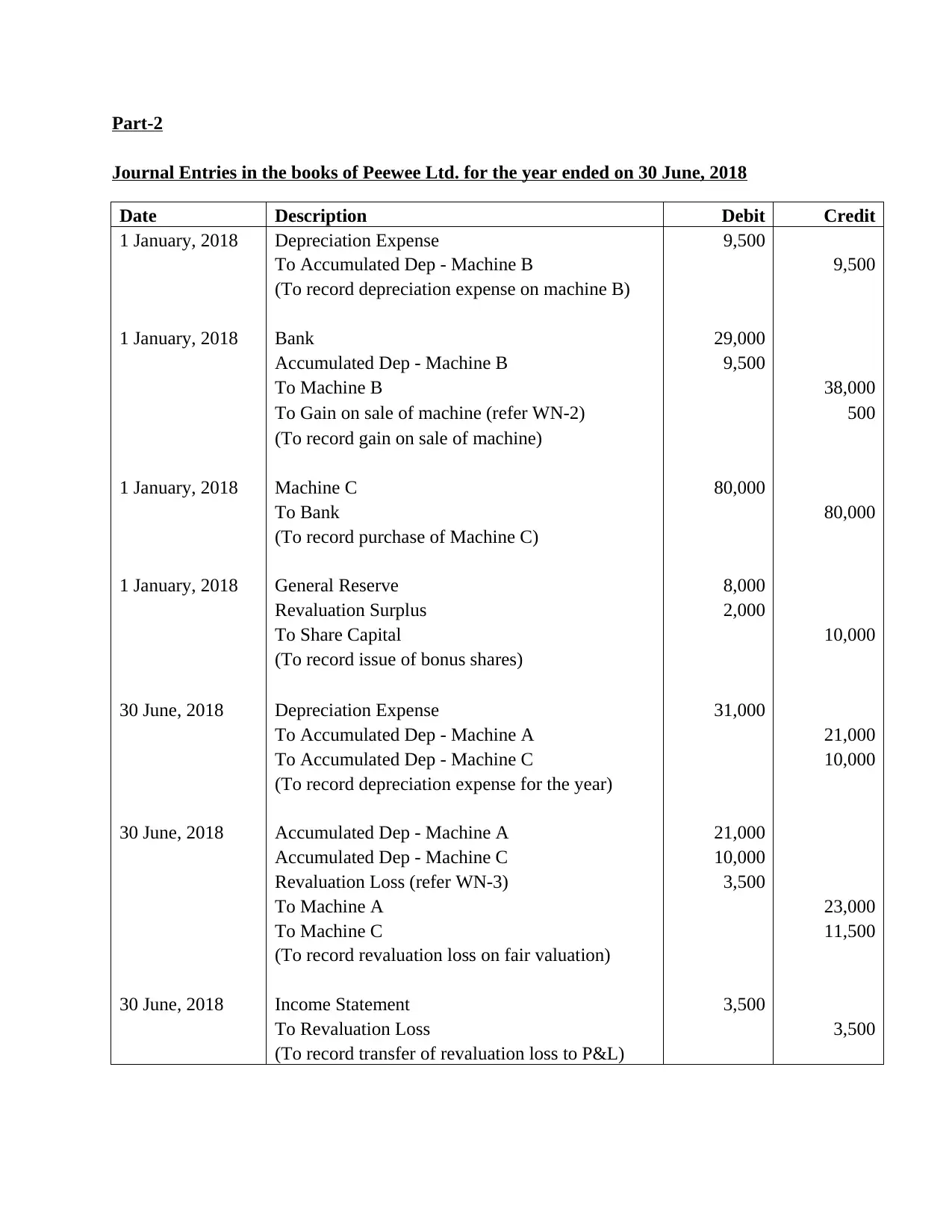
Part-2
Journal Entries in the books of Peewee Ltd. for the year ended on 30 June, 2018
Date Description Debit Credit
1 January, 2018 Depreciation Expense 9,500
To Accumulated Dep - Machine B 9,500
(To record depreciation expense on machine B)
1 January, 2018 Bank 29,000
Accumulated Dep - Machine B 9,500
To Machine B 38,000
To Gain on sale of machine (refer WN-2) 500
(To record gain on sale of machine)
1 January, 2018 Machine C 80,000
To Bank 80,000
(To record purchase of Machine C)
1 January, 2018 General Reserve 8,000
Revaluation Surplus 2,000
To Share Capital 10,000
(To record issue of bonus shares)
30 June, 2018 Depreciation Expense 31,000
To Accumulated Dep - Machine A 21,000
To Accumulated Dep - Machine C 10,000
(To record depreciation expense for the year)
30 June, 2018 Accumulated Dep - Machine A 21,000
Accumulated Dep - Machine C 10,000
Revaluation Loss (refer WN-3) 3,500
To Machine A 23,000
To Machine C 11,500
(To record revaluation loss on fair valuation)
30 June, 2018 Income Statement 3,500
To Revaluation Loss 3,500
(To record transfer of revaluation loss to P&L)
Journal Entries in the books of Peewee Ltd. for the year ended on 30 June, 2018
Date Description Debit Credit
1 January, 2018 Depreciation Expense 9,500
To Accumulated Dep - Machine B 9,500
(To record depreciation expense on machine B)
1 January, 2018 Bank 29,000
Accumulated Dep - Machine B 9,500
To Machine B 38,000
To Gain on sale of machine (refer WN-2) 500
(To record gain on sale of machine)
1 January, 2018 Machine C 80,000
To Bank 80,000
(To record purchase of Machine C)
1 January, 2018 General Reserve 8,000
Revaluation Surplus 2,000
To Share Capital 10,000
(To record issue of bonus shares)
30 June, 2018 Depreciation Expense 31,000
To Accumulated Dep - Machine A 21,000
To Accumulated Dep - Machine C 10,000
(To record depreciation expense for the year)
30 June, 2018 Accumulated Dep - Machine A 21,000
Accumulated Dep - Machine C 10,000
Revaluation Loss (refer WN-3) 3,500
To Machine A 23,000
To Machine C 11,500
(To record revaluation loss on fair valuation)
30 June, 2018 Income Statement 3,500
To Revaluation Loss 3,500
(To record transfer of revaluation loss to P&L)
⊘ This is a preview!⊘
Do you want full access?
Subscribe today to unlock all pages.

Trusted by 1+ million students worldwide
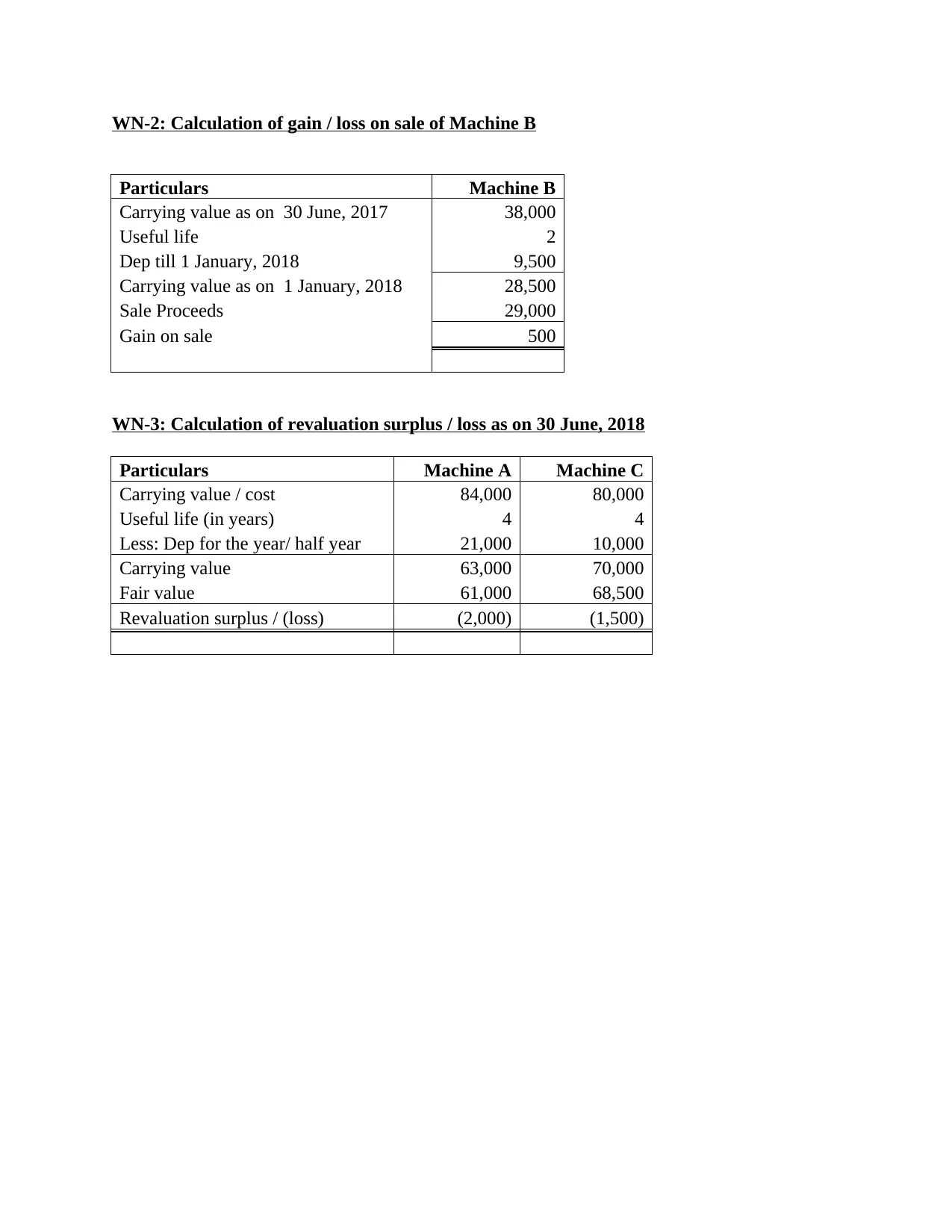
WN-2: Calculation of gain / loss on sale of Machine B
Particulars Machine B
Carrying value as on 30 June, 2017 38,000
Useful life 2
Dep till 1 January, 2018 9,500
Carrying value as on 1 January, 2018 28,500
Sale Proceeds 29,000
Gain on sale 500
WN-3: Calculation of revaluation surplus / loss as on 30 June, 2018
Particulars Machine A Machine C
Carrying value / cost 84,000 80,000
Useful life (in years) 4 4
Less: Dep for the year/ half year 21,000 10,000
Carrying value 63,000 70,000
Fair value 61,000 68,500
Revaluation surplus / (loss) (2,000) (1,500)
Particulars Machine B
Carrying value as on 30 June, 2017 38,000
Useful life 2
Dep till 1 January, 2018 9,500
Carrying value as on 1 January, 2018 28,500
Sale Proceeds 29,000
Gain on sale 500
WN-3: Calculation of revaluation surplus / loss as on 30 June, 2018
Particulars Machine A Machine C
Carrying value / cost 84,000 80,000
Useful life (in years) 4 4
Less: Dep for the year/ half year 21,000 10,000
Carrying value 63,000 70,000
Fair value 61,000 68,500
Revaluation surplus / (loss) (2,000) (1,500)
Paraphrase This Document
Need a fresh take? Get an instant paraphrase of this document with our AI Paraphraser
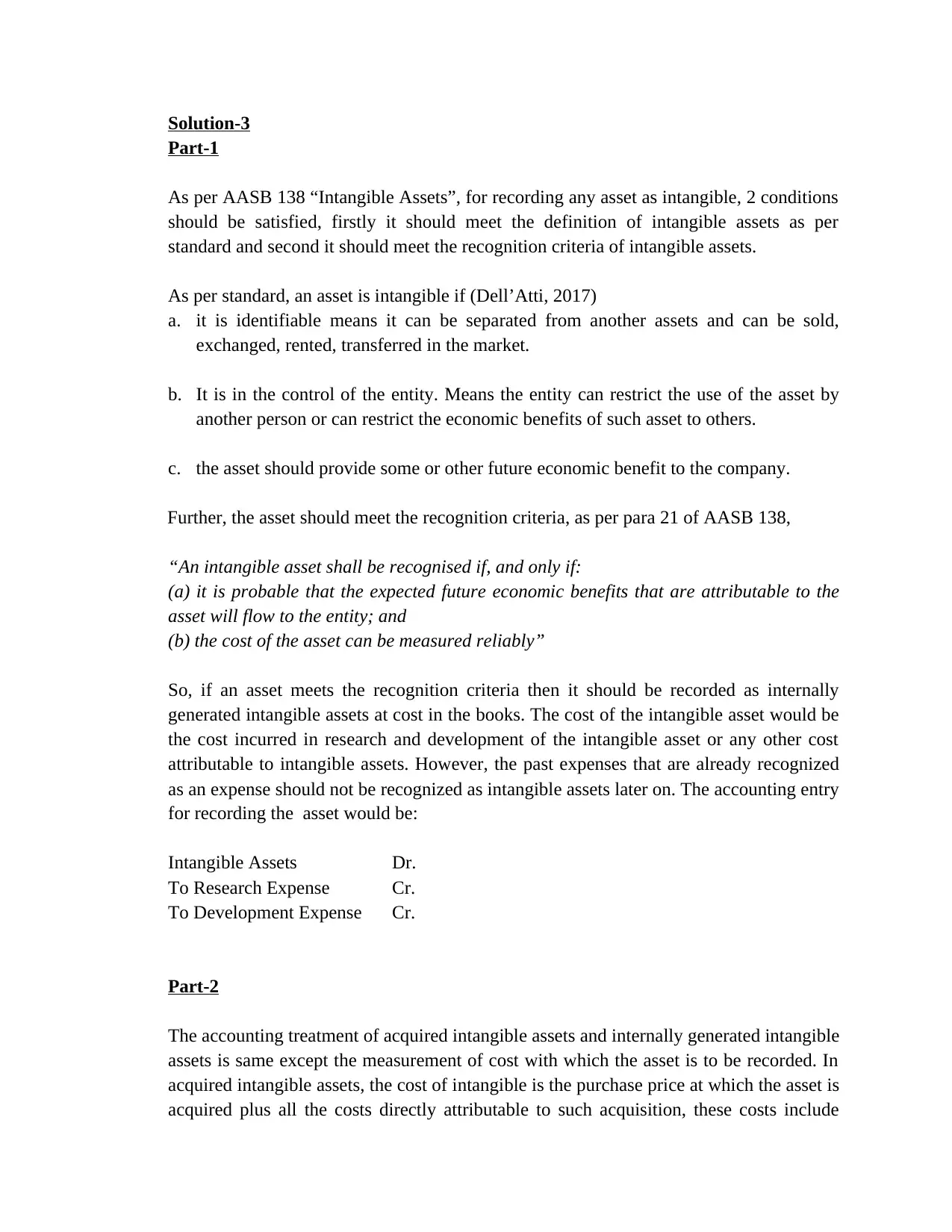
Solution-3
Part-1
As per AASB 138 “Intangible Assets”, for recording any asset as intangible, 2 conditions
should be satisfied, firstly it should meet the definition of intangible assets as per
standard and second it should meet the recognition criteria of intangible assets.
As per standard, an asset is intangible if (Dell’Atti, 2017)
a. it is identifiable means it can be separated from another assets and can be sold,
exchanged, rented, transferred in the market.
b. It is in the control of the entity. Means the entity can restrict the use of the asset by
another person or can restrict the economic benefits of such asset to others.
c. the asset should provide some or other future economic benefit to the company.
Further, the asset should meet the recognition criteria, as per para 21 of AASB 138,
“An intangible asset shall be recognised if, and only if:
(a) it is probable that the expected future economic benefits that are attributable to the
asset will flow to the entity; and
(b) the cost of the asset can be measured reliably”
So, if an asset meets the recognition criteria then it should be recorded as internally
generated intangible assets at cost in the books. The cost of the intangible asset would be
the cost incurred in research and development of the intangible asset or any other cost
attributable to intangible assets. However, the past expenses that are already recognized
as an expense should not be recognized as intangible assets later on. The accounting entry
for recording the asset would be:
Intangible Assets Dr.
To Research Expense Cr.
To Development Expense Cr.
Part-2
The accounting treatment of acquired intangible assets and internally generated intangible
assets is same except the measurement of cost with which the asset is to be recorded. In
acquired intangible assets, the cost of intangible is the purchase price at which the asset is
acquired plus all the costs directly attributable to such acquisition, these costs include
Part-1
As per AASB 138 “Intangible Assets”, for recording any asset as intangible, 2 conditions
should be satisfied, firstly it should meet the definition of intangible assets as per
standard and second it should meet the recognition criteria of intangible assets.
As per standard, an asset is intangible if (Dell’Atti, 2017)
a. it is identifiable means it can be separated from another assets and can be sold,
exchanged, rented, transferred in the market.
b. It is in the control of the entity. Means the entity can restrict the use of the asset by
another person or can restrict the economic benefits of such asset to others.
c. the asset should provide some or other future economic benefit to the company.
Further, the asset should meet the recognition criteria, as per para 21 of AASB 138,
“An intangible asset shall be recognised if, and only if:
(a) it is probable that the expected future economic benefits that are attributable to the
asset will flow to the entity; and
(b) the cost of the asset can be measured reliably”
So, if an asset meets the recognition criteria then it should be recorded as internally
generated intangible assets at cost in the books. The cost of the intangible asset would be
the cost incurred in research and development of the intangible asset or any other cost
attributable to intangible assets. However, the past expenses that are already recognized
as an expense should not be recognized as intangible assets later on. The accounting entry
for recording the asset would be:
Intangible Assets Dr.
To Research Expense Cr.
To Development Expense Cr.
Part-2
The accounting treatment of acquired intangible assets and internally generated intangible
assets is same except the measurement of cost with which the asset is to be recorded. In
acquired intangible assets, the cost of intangible is the purchase price at which the asset is
acquired plus all the costs directly attributable to such acquisition, these costs include
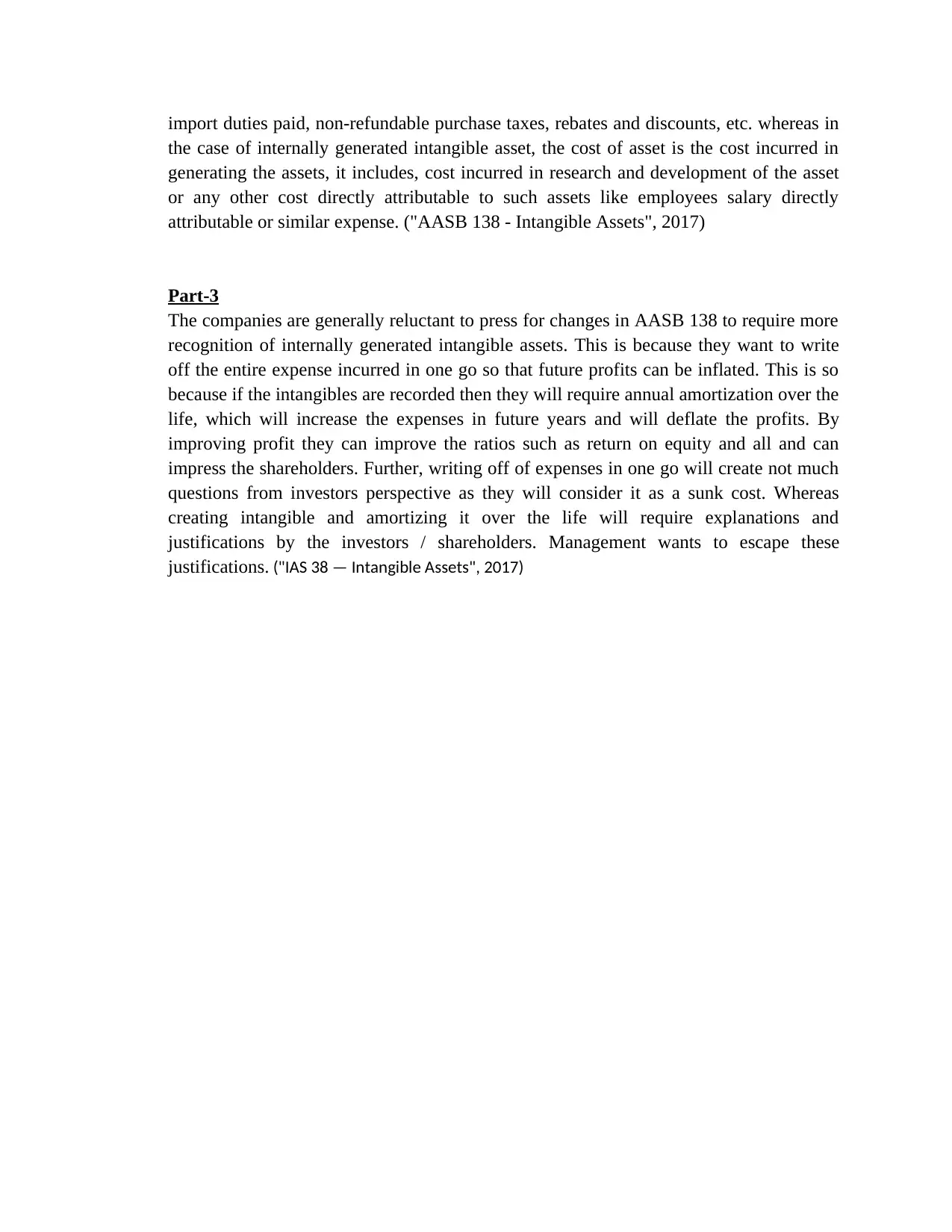
import duties paid, non-refundable purchase taxes, rebates and discounts, etc. whereas in
the case of internally generated intangible asset, the cost of asset is the cost incurred in
generating the assets, it includes, cost incurred in research and development of the asset
or any other cost directly attributable to such assets like employees salary directly
attributable or similar expense. ("AASB 138 - Intangible Assets", 2017)
Part-3
The companies are generally reluctant to press for changes in AASB 138 to require more
recognition of internally generated intangible assets. This is because they want to write
off the entire expense incurred in one go so that future profits can be inflated. This is so
because if the intangibles are recorded then they will require annual amortization over the
life, which will increase the expenses in future years and will deflate the profits. By
improving profit they can improve the ratios such as return on equity and all and can
impress the shareholders. Further, writing off of expenses in one go will create not much
questions from investors perspective as they will consider it as a sunk cost. Whereas
creating intangible and amortizing it over the life will require explanations and
justifications by the investors / shareholders. Management wants to escape these
justifications. ("IAS 38 — Intangible Assets", 2017)
the case of internally generated intangible asset, the cost of asset is the cost incurred in
generating the assets, it includes, cost incurred in research and development of the asset
or any other cost directly attributable to such assets like employees salary directly
attributable or similar expense. ("AASB 138 - Intangible Assets", 2017)
Part-3
The companies are generally reluctant to press for changes in AASB 138 to require more
recognition of internally generated intangible assets. This is because they want to write
off the entire expense incurred in one go so that future profits can be inflated. This is so
because if the intangibles are recorded then they will require annual amortization over the
life, which will increase the expenses in future years and will deflate the profits. By
improving profit they can improve the ratios such as return on equity and all and can
impress the shareholders. Further, writing off of expenses in one go will create not much
questions from investors perspective as they will consider it as a sunk cost. Whereas
creating intangible and amortizing it over the life will require explanations and
justifications by the investors / shareholders. Management wants to escape these
justifications. ("IAS 38 — Intangible Assets", 2017)
⊘ This is a preview!⊘
Do you want full access?
Subscribe today to unlock all pages.

Trusted by 1+ million students worldwide
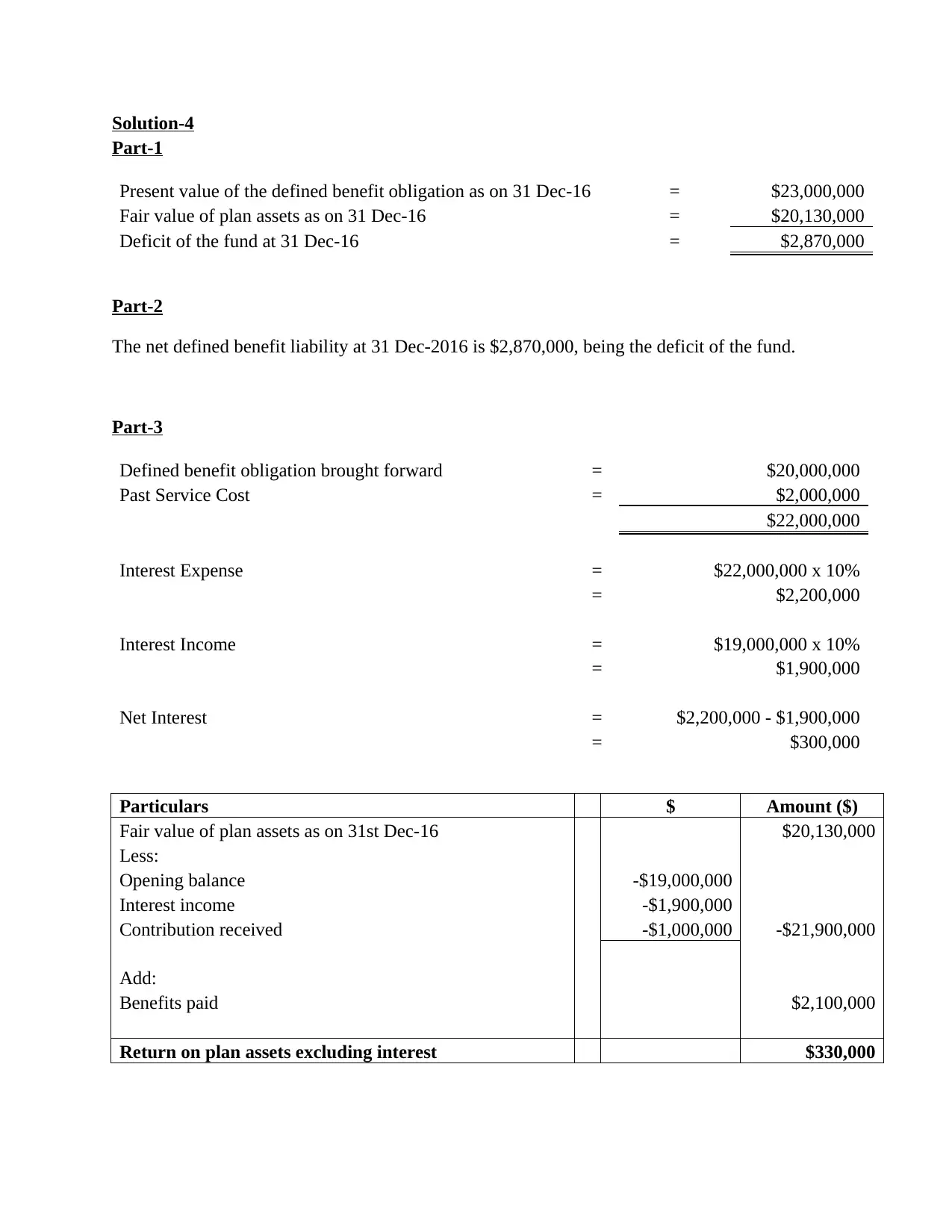
Solution-4
Part-1
Present value of the defined benefit obligation as on 31 Dec-16 = $23,000,000
Fair value of plan assets as on 31 Dec-16 = $20,130,000
Deficit of the fund at 31 Dec-16 = $2,870,000
Part-2
The net defined benefit liability at 31 Dec-2016 is $2,870,000, being the deficit of the fund.
Part-3
Defined benefit obligation brought forward = $20,000,000
Past Service Cost = $2,000,000
$22,000,000
Interest Expense = $22,000,000 x 10%
= $2,200,000
Interest Income = $19,000,000 x 10%
= $1,900,000
Net Interest = $2,200,000 - $1,900,000
= $300,000
Particulars $ Amount ($)
Fair value of plan assets as on 31st Dec-16 $20,130,000
Less:
Opening balance -$19,000,000
Interest income -$1,900,000
Contribution received -$1,000,000 -$21,900,000
Add:
Benefits paid $2,100,000
Return on plan assets excluding interest $330,000
Part-1
Present value of the defined benefit obligation as on 31 Dec-16 = $23,000,000
Fair value of plan assets as on 31 Dec-16 = $20,130,000
Deficit of the fund at 31 Dec-16 = $2,870,000
Part-2
The net defined benefit liability at 31 Dec-2016 is $2,870,000, being the deficit of the fund.
Part-3
Defined benefit obligation brought forward = $20,000,000
Past Service Cost = $2,000,000
$22,000,000
Interest Expense = $22,000,000 x 10%
= $2,200,000
Interest Income = $19,000,000 x 10%
= $1,900,000
Net Interest = $2,200,000 - $1,900,000
= $300,000
Particulars $ Amount ($)
Fair value of plan assets as on 31st Dec-16 $20,130,000
Less:
Opening balance -$19,000,000
Interest income -$1,900,000
Contribution received -$1,000,000 -$21,900,000
Add:
Benefits paid $2,100,000
Return on plan assets excluding interest $330,000
Paraphrase This Document
Need a fresh take? Get an instant paraphrase of this document with our AI Paraphraser
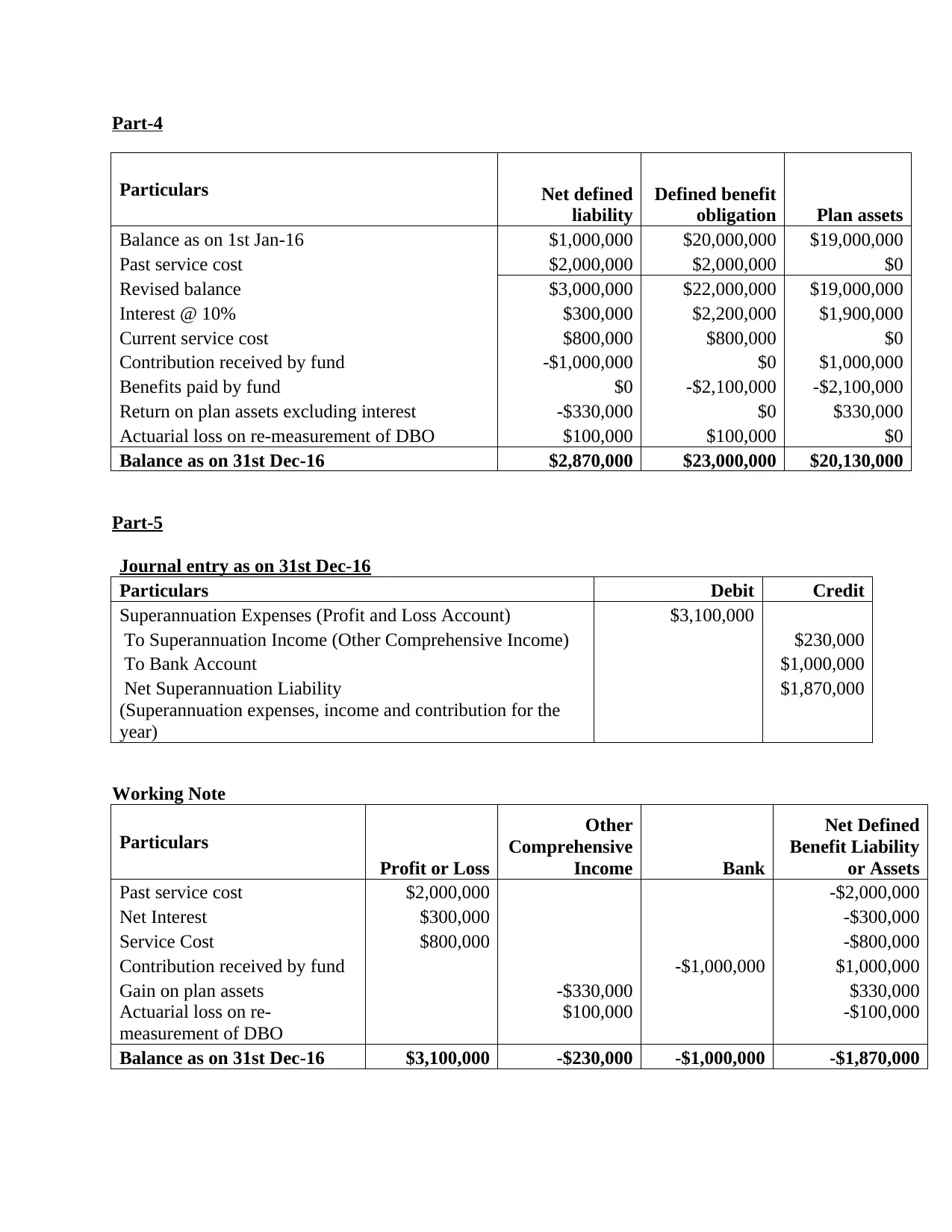
Part-4
Particulars Net defined
liability
Defined benefit
obligation Plan assets
Balance as on 1st Jan-16 $1,000,000 $20,000,000 $19,000,000
Past service cost $2,000,000 $2,000,000 $0
Revised balance $3,000,000 $22,000,000 $19,000,000
Interest @ 10% $300,000 $2,200,000 $1,900,000
Current service cost $800,000 $800,000 $0
Contribution received by fund -$1,000,000 $0 $1,000,000
Benefits paid by fund $0 -$2,100,000 -$2,100,000
Return on plan assets excluding interest -$330,000 $0 $330,000
Actuarial loss on re-measurement of DBO $100,000 $100,000 $0
Balance as on 31st Dec-16 $2,870,000 $23,000,000 $20,130,000
Part-5
Journal entry as on 31st Dec-16
Particulars Debit Credit
Superannuation Expenses (Profit and Loss Account) $3,100,000
To Superannuation Income (Other Comprehensive Income) $230,000
To Bank Account $1,000,000
Net Superannuation Liability $1,870,000
(Superannuation expenses, income and contribution for the
year)
Working Note
Particulars
Profit or Loss
Other
Comprehensive
Income Bank
Net Defined
Benefit Liability
or Assets
Past service cost $2,000,000 -$2,000,000
Net Interest $300,000 -$300,000
Service Cost $800,000 -$800,000
Contribution received by fund -$1,000,000 $1,000,000
Gain on plan assets -$330,000 $330,000
Actuarial loss on re-
measurement of DBO
$100,000 -$100,000
Balance as on 31st Dec-16 $3,100,000 -$230,000 -$1,000,000 -$1,870,000
Particulars Net defined
liability
Defined benefit
obligation Plan assets
Balance as on 1st Jan-16 $1,000,000 $20,000,000 $19,000,000
Past service cost $2,000,000 $2,000,000 $0
Revised balance $3,000,000 $22,000,000 $19,000,000
Interest @ 10% $300,000 $2,200,000 $1,900,000
Current service cost $800,000 $800,000 $0
Contribution received by fund -$1,000,000 $0 $1,000,000
Benefits paid by fund $0 -$2,100,000 -$2,100,000
Return on plan assets excluding interest -$330,000 $0 $330,000
Actuarial loss on re-measurement of DBO $100,000 $100,000 $0
Balance as on 31st Dec-16 $2,870,000 $23,000,000 $20,130,000
Part-5
Journal entry as on 31st Dec-16
Particulars Debit Credit
Superannuation Expenses (Profit and Loss Account) $3,100,000
To Superannuation Income (Other Comprehensive Income) $230,000
To Bank Account $1,000,000
Net Superannuation Liability $1,870,000
(Superannuation expenses, income and contribution for the
year)
Working Note
Particulars
Profit or Loss
Other
Comprehensive
Income Bank
Net Defined
Benefit Liability
or Assets
Past service cost $2,000,000 -$2,000,000
Net Interest $300,000 -$300,000
Service Cost $800,000 -$800,000
Contribution received by fund -$1,000,000 $1,000,000
Gain on plan assets -$330,000 $330,000
Actuarial loss on re-
measurement of DBO
$100,000 -$100,000
Balance as on 31st Dec-16 $3,100,000 -$230,000 -$1,000,000 -$1,870,000
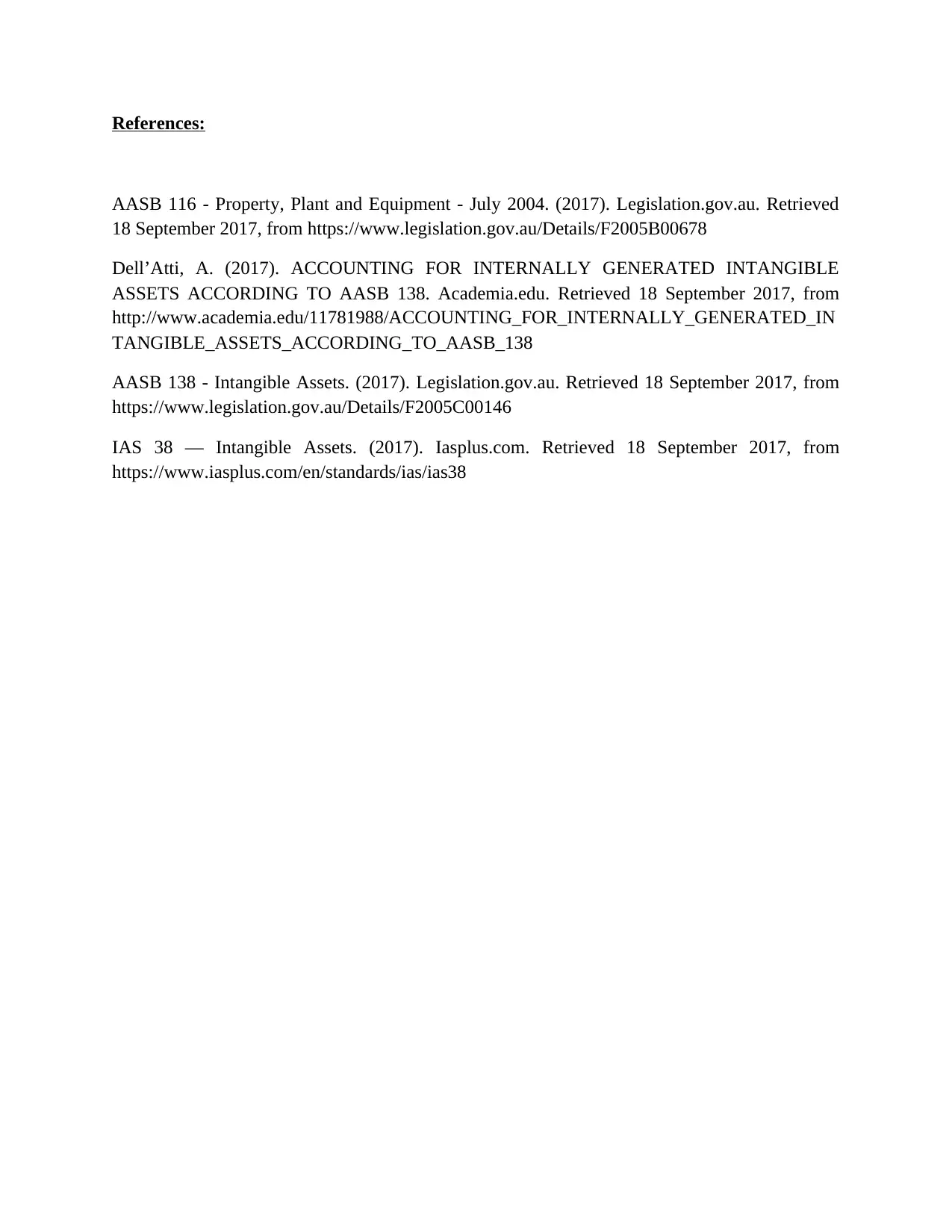
References:
AASB 116 - Property, Plant and Equipment - July 2004. (2017). Legislation.gov.au. Retrieved
18 September 2017, from https://www.legislation.gov.au/Details/F2005B00678
Dell’Atti, A. (2017). ACCOUNTING FOR INTERNALLY GENERATED INTANGIBLE
ASSETS ACCORDING TO AASB 138. Academia.edu. Retrieved 18 September 2017, from
http://www.academia.edu/11781988/ACCOUNTING_FOR_INTERNALLY_GENERATED_IN
TANGIBLE_ASSETS_ACCORDING_TO_AASB_138
AASB 138 - Intangible Assets. (2017). Legislation.gov.au. Retrieved 18 September 2017, from
https://www.legislation.gov.au/Details/F2005C00146
IAS 38 — Intangible Assets. (2017). Iasplus.com. Retrieved 18 September 2017, from
https://www.iasplus.com/en/standards/ias/ias38
AASB 116 - Property, Plant and Equipment - July 2004. (2017). Legislation.gov.au. Retrieved
18 September 2017, from https://www.legislation.gov.au/Details/F2005B00678
Dell’Atti, A. (2017). ACCOUNTING FOR INTERNALLY GENERATED INTANGIBLE
ASSETS ACCORDING TO AASB 138. Academia.edu. Retrieved 18 September 2017, from
http://www.academia.edu/11781988/ACCOUNTING_FOR_INTERNALLY_GENERATED_IN
TANGIBLE_ASSETS_ACCORDING_TO_AASB_138
AASB 138 - Intangible Assets. (2017). Legislation.gov.au. Retrieved 18 September 2017, from
https://www.legislation.gov.au/Details/F2005C00146
IAS 38 — Intangible Assets. (2017). Iasplus.com. Retrieved 18 September 2017, from
https://www.iasplus.com/en/standards/ias/ias38
⊘ This is a preview!⊘
Do you want full access?
Subscribe today to unlock all pages.

Trusted by 1+ million students worldwide
1 out of 9
Related Documents
Your All-in-One AI-Powered Toolkit for Academic Success.
+13062052269
info@desklib.com
Available 24*7 on WhatsApp / Email
![[object Object]](/_next/static/media/star-bottom.7253800d.svg)
Unlock your academic potential
Copyright © 2020–2025 A2Z Services. All Rights Reserved. Developed and managed by ZUCOL.





